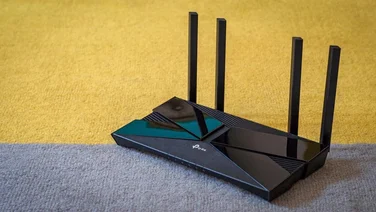To help us provide you with free impartial advice, we may earn a commission if you buy through links on our site. Learn more




Cyberoam’s NetGenie is a wireless router specifically designed to keep your family safe from the nastier parts of the internet when online. It doesn’t have a built-in ADSL modem, so you’ll need to use a modem or plug another router into it.
To this end it not only has built-in virus detection, but also has a comprehensive set of filters to control what the various members of your household can and can’t view online. In the web interface you can create a separate user for each member of your household, complete with obligatory password for anyone over eight years old (you can set a password for the young ‘uns, but the router sensibly suggests that they may have trouble remembering it.) When each member of the household opens a web browser, they first have to log in before they can access any web sites.

You then have a large range of options for each user, to help you make their browsing as locked-down or permissive as you wish. To start, you set their approximate age – 8, 12, 17, 21 or Adult. This gives you a baseline web filter which you can then customise. For example, for eight-year-olds everything is locked down bar a handful of sites such as kids.yahoo.com and kids.discovery.com, while at the Adult setting everything is permitted except for porn and sites known to host malware.

Default settings for an eight-year old – click to enlarge
There are 87 categories of website, split into recommend sets for each age group, and you can permit or block access to each category with a simple click – the interface is incredibly simple to use. You can also restrict access at certain times of day – stopping your teenage child accessing Facebook when they should be doing homework, for example. However, we found that for the timed access to work we had to set it for five hours ahead of the time we actually wanted, even though the time set in the router was correct. You can also add sites to custom white- and blacklists for each user, so they will always have access to certain sites or have that access blocked. You can also whitelist a certain device, so that PC, tablet or smartphone will always be able to do what it likes online.
When you try to access a blocked website, you are shown a screen telling you why, and giving you the option to log in as a different user or to override the block with the administrator username and password. The system worked well; our only problem was that there was no time out for individual users; we stayed logged in as an Adult even when we changed users in Windows 7. Unless each member of your household has their own PC, we’d recommend always getting those with more permissive settings to log out of the system before letting a younger member use the PC.
The rest of the router’s interface is well designed and very easy to use; there’s no QoS, apart from a blanket limit for upload and download rates for the router, but the port forwarding and wireless networking interfaces are well designed. You can plug a 3G USB modem into the router’s USB port to share a 3G connection; to get a 3 Premium Broadband dongle to work we just had to type in the three.co.uk APN and add *99# as the dial-up number; you can find settings for other networks at http://tinyurl.com/644hdz.

The router’s admin settings – click to enlarge
Unfortunately, the router was slow in our file transfer tests. When testing with a Centrino laptop, at 1m range we saw just 27.1Mbit/s, while at 10m this dropped to 5.9Mbit/s and at 25m a crawling 2.1Mbit/s. Cyberoam doesn’t have its own USB dongle, but when we tested with a Dynamode WL-700N-MRT (£6 from www.scan.co.uk) we saw a large improvement to 27.1Mbit/s at 10m; unfortunately, we couldn’t hold a signal at 25m using the Dynamode dongle.
Cyberoam’s NetGenie router is a good idea that generally does a good job of filtering content for the various members of your family – it makes sense to do this at the router level, as it will then apply to any device that connects to the wireless network, whether it’s a laptop, a tablet or a smartphone. All this comes at a price, though; it’s the same price as some premium dual-band routers, and the NetGenie is a slow single-band model. Also, after three years you’ll need to buy a further £89 subscription to keep your website categories and virus definitions up to date.






